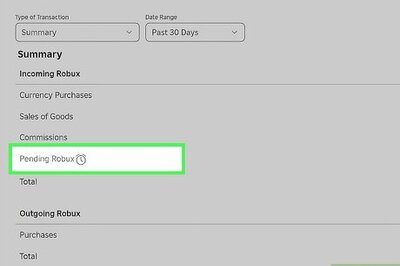
views
Gathering Vendor Information

Assess your vendor needs. Before you can create a preferred vendors list, you need to know what types of products your company buys on a regular basis. These are the items you will want to find preferred vendors for. Start by asking every department in your company what they use most. For example, if you have an IT department, they might say they use modems, flash drives, and external hard drives all the time. If you have an administrative department, they may continuously purchase ink, toner, paper, pens, and pencils. In addition to asking each individual department what they usually purchase, think about your company as a whole. It could be that no single department buys a lot of printer paper, but your company as a whole could. Therefore, do not forget to look at your company at both a large and small scale.

Find contact information for various vendors. Once you know what types of products your company buys on a regular basis, you will need to find vendors that provide all of those products. Find multiple vendors for each product you need so you can compare each vendor's qualifications and ability to fill your need. As a rule of thumb, try to find 10-15 vendors for each product your regularly purchase. Conduct a quick internet search to try and find vendors. For example, use Google and type in something like: "Vendors for printer paper, ink, and cartridges." Check with out-of-state vendors as well. While you will have to pay extra shipping costs to get their products to you, their prices may be so good that it makes up for the increased shipping. For example, assume an in-state vendor charges $250 for each bulk ink cartridge order and will ship them for free. Next, assume an out-of-state vendor charges $175 for each bulk ink cartridge order and will ship each order for $45. In this scenario, the total cost of using the in-state vendor would be $250 while the total cost of using the out-of-state vendor would be $220. As you find possible vendors, write down their contact information so you know where to send requests and other correspondence as you work to create a preferred vendors list.

Create a Request For Information (RFI) form. An RFI is the formal document you will send out to each potential vendor. This document will ask each vendor to respond to a number of inquiries so you can get an idea of which vendors might be a good fit. The form should be created using official company letterhead and it should be typed up on a computer using a legible font (e.g., Times New Roman). Check online for templates you might be able to use. If you find a template, make sure you customize it to fit your needs. Do not simply copy and paste everything from the template onto your letterhead.

Include a request for personal information. After a brief introduction that includes information telling the vendors about your request, start by asking for each vendor's personal information. This should include the company's name, address, phone number, email address, point of contact, and tax identification numbers.

Ask for pricing. The next portion of your RFI should ask the vendors to attach pricing for the products you frequently purchase. A quality pricing document will contain price levels for various options including higher and lower quality products, bulk and individual orders, and various shipping costs depending on how quick you need access to the products. In addition, pricing documents might include a description of other services provided by the vendor, which could include troubleshooting, in-person support, and installation services.

Verify each company's history. Each RFI you send to potential vendors needs to include a request for certain corporate documents that will allow you to assess the stability and legality of the vendors you might choose to work with. For example, you might ask each possible vendor to send you a proof of insurance form you can use to verify that each vendor has the appropriate amount of insurance. In addition, you might ask each vendor to submit a list of employees so you can check their names against government watchlists, criminal databases, and politically exposed persons databases.

Inquire about any other information you might find important. Your RFI should touch on everything you think is necessary to make an informed decision. If you are going to work with a specific vendor, you should know: When the company began What their strategy is What the form of their business is What type of customers the vendor has The vendor's financial stability Their delivery track record Their involvement in the community Their process for dispute resolution

Send your RFI to each possible vendor. When your RFIs have been completed, mail them to every vendor candidate you have. Along with each RFI, send a quick introductory letter explaining that you are trying to put together a preferred vendors list. Kindly ask that they complete the RFI and return it as soon as possible. Let each vendor know that they should feel free to include any other additional information, even if it is not specifically requested, if they think it will help you make a decision.

File every response. As you receive completed RFIs, file them away in categorized piles. For example, keep all ink and toner vendors together and all external hard drive vendors together. Give every vendor a reasonable amount of time to complete and send back their RFI before starting the review process.
Evaluating the Results

Build a review team. When it comes time to review the completed RFIs, put a team of employees together to evaluate them. The team you put together should be a diverse cross-section of your company so every department is represented and so you receive as many different perspectives as possible. Make sure you include financial experts and lawyers so they can review each RFI from their professional perspectives.

Screen for an initial fit. Once your team has been created, take time on a weekly basis to sit down together and screen RFIs. The initial screening process should simply look to weed out vendors that do not fit your needs. For example, if a vendor submits an RFI stating they can only provide laptop computers, but your company does not have a need for laptop computers, you can quickly cross them off the list. Additionally, look for vendors that do not fit in with your corporate style. For example, if a vendor requests payment every 15 days, but your company only pays in monthly installments, you may want to cross them off the list.

Look for red flags in the returned RFIs. Each remaining RFI should be reviewed for fit and qualification. Each reviewer should take notes and keep track of any red flags that pop up in particular RFIs. Red flags could be anything that gives a reviewer pause about using that particular vendor on your preferred list. If you find too many red flags in any one RFI, that vendor should be removed from consideration. Common red flags in RFIs include: Inadequate financial resources A poor performance record A dishonest reputation Prior civil or criminal liability A history of fraud Deals that seem to good to be true Corporate structures that do not make sense

Conduct interviews with possible vendors. Once you have narrowed your list of possible vendors down, contact each one and conduct a second level of review. Let each vendor know that they have made it to the second level of review. You should also tell them you would like to interview some key employees that you would likely be working with should they make it on your preferred vendors list. When you conduct these interviews, keep the questions related to the business relationship you could possibly be forming. For example, you might ask how the employee handles orders they receive, how they bill, and whether they have ever had any trouble with companies they worked with in the past.

Test the vendor's reputation. In addition to interviewing employee's within the vendor's company, ask questions of other people in the vendor's industry. When you interview these people, ask about the vendor's reputation and integrity. These people will often give you the most honest information of anyone. However, be careful when asking questions to a vendor's competition. These people will often be biased and may not give you completely honest answers. Try to stick to as much objective information as you can find.

Perform site visits. As a final level of review for all the vendors who have made it this far, send a request asking for access to their place of business. Use this opportunity to review procedures to make sure their facilities are in working order and that their employees are ready to fulfill your needs. Meet with key employees you would be working with and consider whether the vendor would be a good fit with your business.
Creating Your List

Request that each vendor sign a terms and conditions sheet. When you have a list of vendors who meet your qualifications and who can offer their products at an acceptable price, send a letter to each one informing them that you would like to add them to your preferred vendors list. As a prerequisite to being included on your preferred vendors list, each vendor should be required to sign a terms and conditions sheet. This document will lay out the terms of your agreement with each individual vendor. It needs to include, among other things, the pricing of their products, how order need to be made, how billing will work, and how disputes will be settled.

Create a vendor list. All of the vendors that sign your terms and conditions sheet should then be input into your final preferred vendors list. Check online for templates you may be able to use. However, the content of your preferred vendors list is more important than the format of it.

Include the vendor's important personal information. Your preferred vendors list should be categorized by department, so each of your company's departments can easily find who to contact for various product needs. Under each department's title should be a list of approved vendors for all of the various products that department normally purchases. Each employee at your company should be able to look at the preferred vendors list and determine: The vendor's name The vendor's contact information The products each vendor is approved to sell The pricing of each product

Distribute your list to the necessary employees. Once your list is complete, pass it out to those who need access to it. This list might be accompanied by an internal company memo explaining what the list is and how it should be used.
Tracking Results

Set an internal policy for review. Along with creating a preferred vendors list, you should also set out a policy for reviewing that list periodically. These lists need to be reviewed because business close, pricing changes, and problems arise. Your company should review the preferred vendors list every so often to ensure it is up-to-date and working for the company. A lot of companies will check their lists every two or three years.

Evaluate the results of your initial list. When you create your initial preferred vendors list, check in with your results after several months of having it in use. You want to do this to make sure you are saving money and using the list to its full potential.

Discuss price changes when they arise. Vendors will often increase prices over time. When this happens, review their place on your preferred vendors list and determine if other vendors might give you a better deal. A large part of having a preferred vendors list is to get preferred pricing. If the price is not right, do not continue the relationship.

Look for new players. Just like old vendors on your list might go out of business, new vendors will come into existence that weren't there when you created your initial list. Review the market periodically and look for new vendors. Often, newer companies will offer great deals to help them get consistent business.

Review your list for inactive accounts. One of the last things you can do to review your preferred vendors list is to check and see if particular vendors are being used. In some cases, certain departments in your company may prefer one vendor on the list over another, and that other vendor may not be doing any business with your company. If you find a vendor who is on your list but is inactive (i.e., not doing business with you), consider taking them off the list to make room for another vendor.

















Comments
0 comment